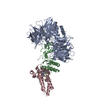+Search query
-Structure paper
| Title | Targeted protein degradation via intramolecular bivalent glues. |
|---|---|
| Journal, issue, pages | Nature, Vol. 627, Issue 8002, Page 204-211, Year 2024 |
| Publish date | Feb 21, 2024 |
 Authors Authors | Oliver Hsia / Matthias Hinterndorfer / Angus D Cowan / Kentaro Iso / Tasuku Ishida / Ramasubramanian Sundaramoorthy / Mark A Nakasone / Hana Imrichova / Caroline Schätz / Andrea Rukavina / Koraljka Husnjak / Martin Wegner / Alejandro Correa-Sáez / Conner Craigon / Ryan Casement / Chiara Maniaci / Andrea Testa / Manuel Kaulich / Ivan Dikic / Georg E Winter / Alessio Ciulli /     |
| PubMed Abstract | Targeted protein degradation is a pharmacological modality that is based on the induced proximity of an E3 ubiquitin ligase and a target protein to promote target ubiquitination and proteasomal ...Targeted protein degradation is a pharmacological modality that is based on the induced proximity of an E3 ubiquitin ligase and a target protein to promote target ubiquitination and proteasomal degradation. This has been achieved either via proteolysis-targeting chimeras (PROTACs)-bifunctional compounds composed of two separate moieties that individually bind the target and E3 ligase, or via molecular glues that monovalently bind either the ligase or the target. Here, using orthogonal genetic screening, biophysical characterization and structural reconstitution, we investigate the mechanism of action of bifunctional degraders of BRD2 and BRD4, termed intramolecular bivalent glues (IBGs), and find that instead of connecting target and ligase in trans as PROTACs do, they simultaneously engage and connect two adjacent domains of the target protein in cis. This conformational change 'glues' BRD4 to the E3 ligases DCAF11 or DCAF16, leveraging intrinsic target-ligase affinities that do not translate to BRD4 degradation in the absence of compound. Structural insights into the ternary BRD4-IBG1-DCAF16 complex guided the rational design of improved degraders of low picomolar potency. We thus introduce a new modality in targeted protein degradation, which works by bridging protein domains in cis to enhance surface complementarity with E3 ligases for productive ubiquitination and degradation. |
 External links External links |  Nature / Nature /  PubMed:38383787 / PubMed:38383787 /  PubMed Central PubMed Central |
| Methods | EM (single particle) |
| Resolution | 3.77 Å |
| Structure data | EMDB-17172, PDB-8ov6: |
| Chemicals |  ChemComp-ZN:  ChemComp-U79: |
| Source |
|
 Keywords Keywords |  TRANSCRIPTION / TRANSCRIPTION /  Bromodomain / BET protein / DCAF16 / Bivalent glue / Targeted protein degradation / TPD Bromodomain / BET protein / DCAF16 / Bivalent glue / Targeted protein degradation / TPD |
 Movie
Movie Controller
Controller Structure viewers
Structure viewers About Yorodumi Papers
About Yorodumi Papers






